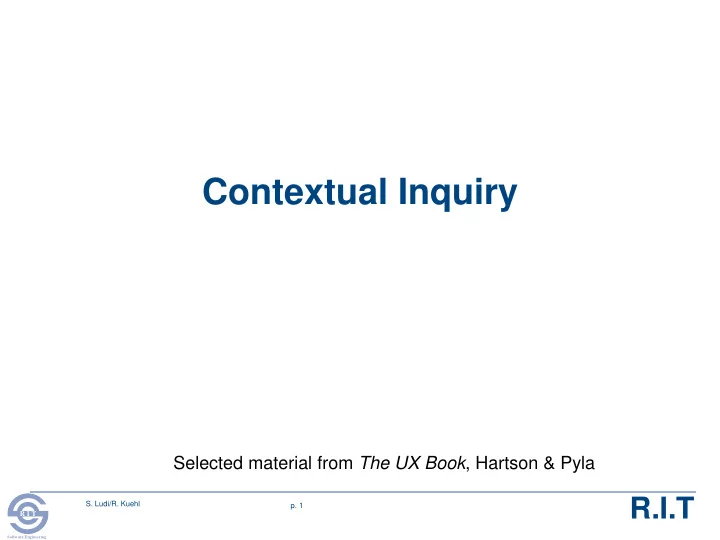

Contextual Inquiry Selected material from The UX Book , Hartson & Pyla R.I.T S. Ludi/R. Kuehl p. 1 R I T Software Engineering
R.I.T S. Ludi/R. Kuehl p. 2 R I T Software Engineering
Definitions Goals Work Work Environment Work Practice Work Activities R.I.T S. Ludi/R. Kuehl p. 3 R I T Software Engineering
Definitions Context - entire context of work and work practice in target work environment Goal: Understand customer’s work practice – how work (play) gets done Work activities – what users do to accomplish goals in a work environment Sensory, cognitive , and physical actions performed while carrying out work practice Not all activities involve system or product usage Example, using SIS to register for courses R.I.T S. Ludi/R. Kuehl p. 4 R I T Software Engineering
Work Practice Collection of work activities performed to complete jobs Involves learned skills and knowledge , decision making , and social interaction Can be based on regulations, tradition, ritual, and habit Pattern of …. Procedures Established actions Approaches Routines Conventions Customs Protocols Physical actions Manual activities R.I.T S. Ludi/R. Kuehl p. 5 R I T Software Engineering
What is Contextual Inquiry? Discovery! R.I.T S. Ludi/R. Kuehl p. 6 R I T Software Engineering
What is Contextual Inquiry? Discover and understand customer/user work practice and associated work activities Underlying rationale - why Goal : improve work practice and construct and/or improve system designs to support it How? Interviews – what they say Observation (and apprenticing) – what they do R.I.T S. Ludi/R. Kuehl p. 7 R I T Software Engineering
System Concept Statement Starting point for contextual inquiry to make sure everyone is on the same page Mission statement for new system to be developed Explains system to outsiders Helps set focus and scope for system development internally Hard to write a good one, iterate Broad audience of stakeholders Typically 100 to 150 words in length R.I.T S. Ludi/R. Kuehl p. 8 R I T Software Engineering
System Concept Statement (cont) Answers these questions… What is the system name ? Who are the system users ? What will the system do ? What problem (s) will the system solve ? What experience will the system provide the user ? Why will it be better than competitors ? R.I.T S. Ludi/R. Kuehl p. 9 R I T Software Engineering
Example System Concept Statement Bicycle Rental System Municipalities want to promote greater use of bicycles in the center city by providing a bike rental system. They are motivated to encourage healthier life styles, and reduce congestion and emissions. They also want to earn extra revenue or at least break even. Bicycles available for rental are distributed in various convenient locations for people to rent for a small fee. Prospective bike riders use their mobile devices to locate the nearest bike rental stand with available bikes based on the location of the individual. Once a suitable bicycle is located, they use their phone to sign the bicycle out for immediate use or reserve it for later use. When the rider is finished with the bicycle, they use their phone to locate another bike stand and drop the bike off. They sign the bike back in and pay the usage fee. They are also requested to input information about the mechanical condition of the bike with a short survey. R.I.T S. Ludi/R. Kuehl p. 10 R I T Software Engineering
CI Preparation Do your homework – learn about the application domain and the business Research – e.g., internal environment, market, technology, terminology, competition, current products/systems Connect with the lead customer (decision maker) Build a relationship Validate the mission statement Plan logistics for interviews and observation – who, when, where R.I.T S. Ludi/R. Kuehl p. 11 R I T Software Engineering
Tips for Interviews and Observation Have a going-in-plan – what questions to you want answered? Utilize the 5W+H heuristic – who, what, why, when, where + how Adapt according to what you learn Goals - what users do , how they deal with problems but also how do they “ feel ”, what are their personal goals ? Work practice and activities Work environment Identify work related information Collect any helpful work related artifacts R.I.T S. Ludi/R. Kuehl p. 12 R I T Software Engineering
Tips for Interviews and Observation (cont) Sessions … Make the user feel at ease, explain the process Don’t lead the witness, have them tell “stories” 1-2 hours max Take notes (record)!!! Have an organizational scheme (“bins”) – e.g., their role, work activities, work environment, social and collaborative relationships, emotional expression, design ideas, … Pitfalls … Hearing not listening Side tracks Your personal bias Is the user speaking the truth? R.I.T S. Ludi/R. Kuehl p. 13 R I T Software Engineering
User Oriented Questions What functions are required, what tasks performed? What workflows are performed on a daily/weekly basis? Unnecessary tasks? How are errors handled? Frequency of tasks? Priorities of tasks? What information is needed to do your job? What is your favorite, least favorite tasks? What shortcuts do you use? Personal goals, motivations? Who else should be interviewed, who do you work with? R.I.T S. Ludi/R. Kuehl p. 14 R I T Software Engineering
Recommend
More recommend